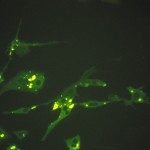Link to Pubmed [PMID] – 12573496
Virus Res. 2003 Feb;91(2):181-7
The oligomeric structure and the fusion activity of lyssavirus glycoprotein (G) was studied by comparing G from Mokola virus (GMok) and rabies virus (PV strain) (GPV), which are highly divergent lyssaviruses. G expressed at the surface of BSR cells upon either plasmid transfection or virus infection are shown to be mainly trimeric after cross-linking experiments. However, solubilization by a detergent (CHAPS) and analysis in sucrose sedimentation gradient evidenced that GMok trimer is less stable than GPV trimer. A chimeric glycoprotein (G Mok-PV) associating the N-terminal half of GMok to the C-terminal half part of GPV formed trimers with an intermediate stability, indicating that the G C-terminal domain is essential in trimer stability. A cell to cell fusion assay revealed that GMok (and not G Mok-PV) was able to induce fusion at a higher pH (0.5 pH unit) than GPV. Such differences in the oligomeric structure stability and in the fusion activity of lyssavirus glycoproteins may partly account for the previously reported differences of their immunogenic and pathogenic properties.

